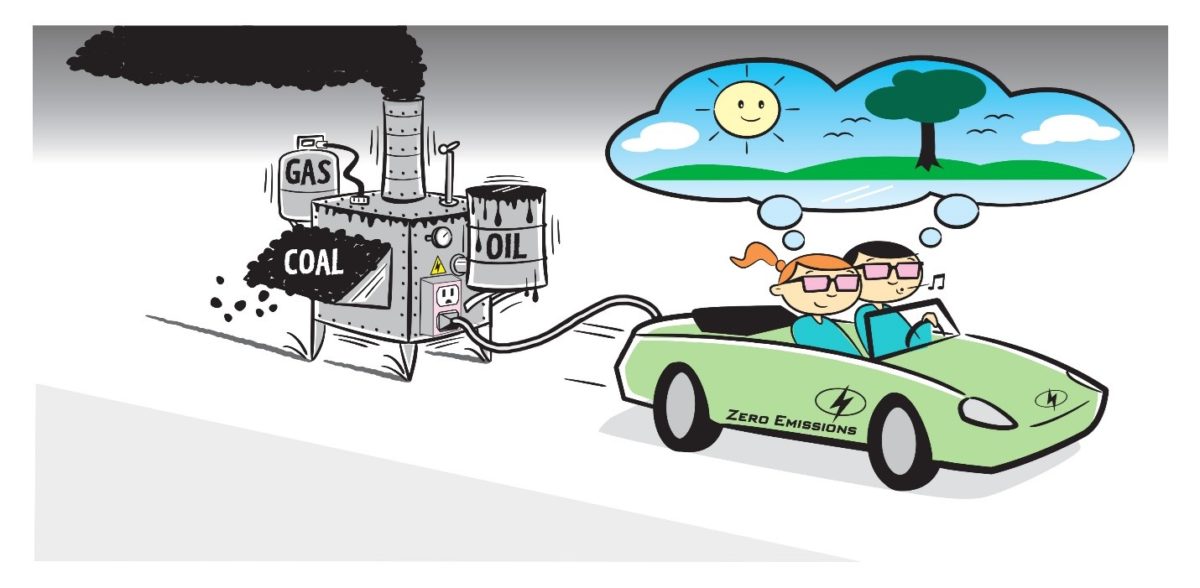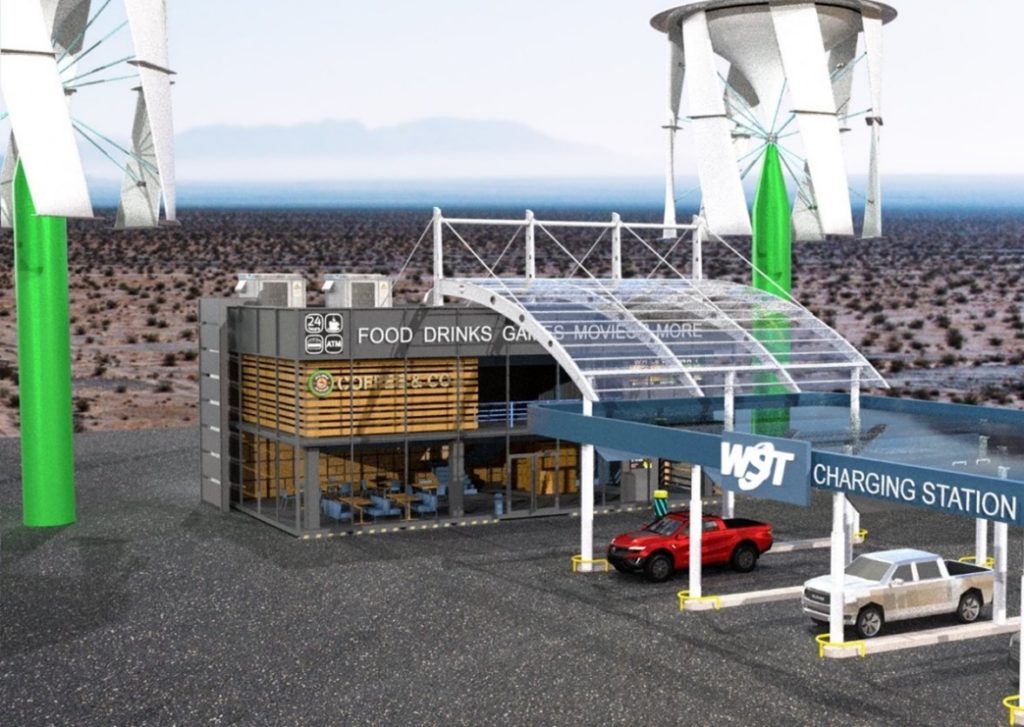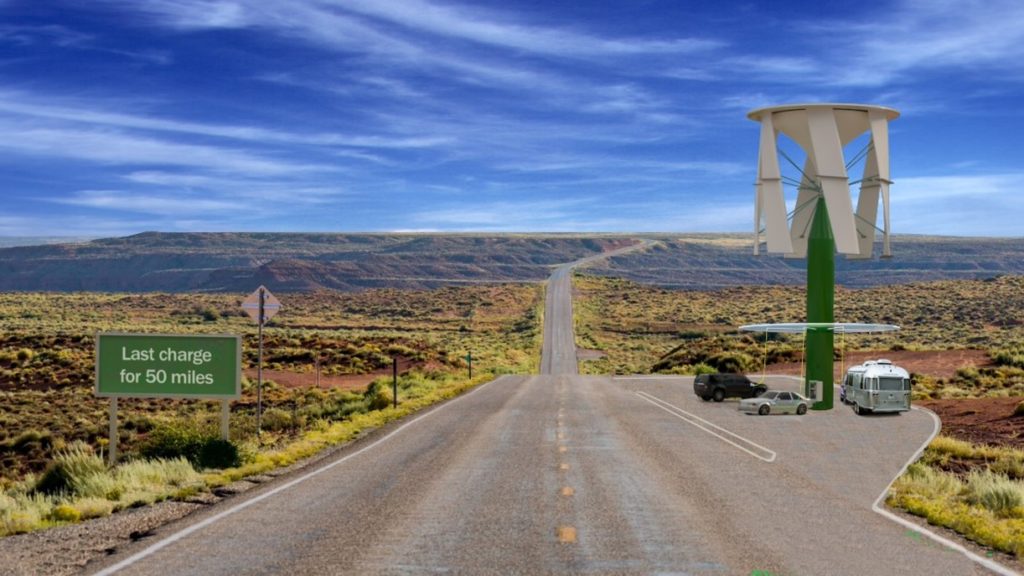“Green” vehicles aren’t as environmentally friendly as most people believe

The Wind & Solar Tower provides Level-4 pollution-free charging
NEW YORK, May 3, 2022 – More than 60 percent of our electric grid is powered by burning dirty fossil fuels. Using that dirty grid to charge electric vehicles (EV) only adds pollution and greenhouse gasses and pollution to the air we breathe.
Improving air quality and helping improve our climate will require pollution-free EV charging methods. While EVs represent an improvement over vehicles that burn gasoline and diesel, better and cleaner charging is needed to lessen greenhouse gas emissions which contribute to climate change.
Due to conversion losses in the electricity generating process, power plants burn almost 3 kilowatt (kw) hours of fuel to deliver 1 kilowatt of electricity to the grid, resulting in a tremendous waste of energy and an increase in pollution. In 2019, utility-scale power plants consumed 38 quadrillion BTUs of energy to provide 14 quadrillion kilowatts of electricity. That means that more than 60 percent of the fuel burned to make electricity is lost to thermal, mechanical and generator inefficiency before a single kilowatt enters the grid. Then, another 5 percent of that electricity is lost within the transmission and distribution grid.

Pollution-free Level-4 DC Charging: Goodbye Dirty Air and Grid Strain
The Energy Information Administration (EIA) of the Department of Energy reports that in 2020, the average American suffered through eight hours of electrical outages. Our grid comprises more than 9,200 generating units and depends on more than 600,000 miles of ~300,000-volt transmission lines that in many cases are 40 years old. There are also millions of miles of low-voltage power lines with distribution transformers, some of which are more than 50 years old. With these weaknesses, the grid is in continual peril of brownouts and blackouts. The only “clean” and sensible way to take pressure off the aging grid is to add distributed renewable generation.
Due to rolling blackouts, California experienced 25,281 electric power outages in 2019, a 23 percent increase from 20,598 in 2018. Those outages victimized 28.4 million electric vehicle customers, a 50 percent increase over the 19 million Californians affected in 2018.
To travel 100 miles, the average EV requires approximately 30 kilowatt hours of electricity. The average American home consumes roughly that amount in an entire day. If EV adoption and single-family home forecasts bear out, by 2030, EVs will consume as much electricity as 35 percent of single-family homes in the U.S. Based on the annual average of 13,474 miles driven by passenger cars and 12,435 by last-mile delivery trucks, EVs will consume more than 137 billion kilowatt hours of electricity per year.
The Pacific Northwest National Laboratory calculates the grid load of a single grid- connected DC fast charge as equal to the electrical consumption of 50 homes during the charging period. Multiplying that load by 18.7 million EV passenger cars and 10.4 million last-mile delivery EV trucks creates a problem in supplying the vast amount of electricity required for charging those vehicles. The overarching challenge becomes how to satisfy this instantaneous power demand, or surge.
Boston Consulting Group predicted in 2019 that to meet increased demand, utilities will need to invest $1,700 to $5,800 per electric vehicle in grid upgrades through 2030. That grid infrastructure upgrade would require an investment of up to $178.7 billion by 2030.
The Wind & Solar Tower: Level-4 DC Ultra-Fast charging, 328 miles of range in only 15 minutes, and 653,000 miles of pollution-free driving per year

One solution that provides the needed clean energy, convenience and fast-charging is Change Wind Corporation’s patented Wind & Solar Tower (WST). It generates 61.5 kW of pollution-free electricity per operating hour for EV charges or any other use. This is made possible by the world’s only charger powered by a combination of wind and sun. Because WSTs do not need a grid connection, they can be installed in rural and remote locations far from a grid. To maximize charge rates and number of charges at ultra-high kilowatt and voltage levels, each WST is equipped with integral battery storage ranging up to one megawatt.
MIT scientists determined that dust and other particulates inhibit solar panel output by up to 30 percent in only a month. Commercial solar installations are estimated to consume 10 billion gallons of water for panel washing. That figure is equivalent to the drinking water consumption of 2 million people. Countering that expensive and wasteful water usage, the WST uses no external water supply, needing only centrifugal force to clean its patented rotating solar panel with fresh morning dew.
Each WST is capable of charging six vehicles simultaneously at Level-4 DC Ultra-Fast charge rates of 6.333 kW per minute that add about 22 miles of range. This metric is based on a conservative estimate of 3.46 miles per kW. Each WST produces more than 188,000 kilowatt hours of electricity annually on site where it is used. This annual production total assumes only a 33-percent wind duty cycle and a 45-percent solar duty cycle. By not relying on the grid, that substantial output is immune to power line resistance losses, brownouts and blackouts.
To put that output into perspective, those ~188,000 kilowatt hours can charge 9,441 EVs with 20-kilowatt DC Ultra-Fast charges. And thanks to that capacity, it takes under 190 seconds — just over 3 minutes — to add 20 kW and approximately 70 miles of pollution-free driving range. As the world’s highest-output Level-4 DC Ultra-Fast charger, with peak charge rates of 380 kW at 1,000 volts, a 15-minute charge delivers 328 miles of range. And, for drivers short on time, a five-minute charge delivers 109.5 miles of range.
Because it uses only wind and sun power, each WST offsets the CO2 emissions from over 594,788 kilowatt hours of power plant electric production at .85 pounds of CO2 per kWh that translates to 252.784 tons of CO2 that each Tower prevents from entering our skies. The WST’s CO2-offset figure above is based on EIA data stating that more than 60 percent of the energy used for electricity generation is lost in conversion.
Burning a gallon of gasoline emits 19.37 pounds of CO2. An EV gets 3.46 miles per kW, so it follows that each WST provides 653,323 miles of 100 percent pollution-free electric-powered driving per year.
Although pollution-free and environmentally friendly, in no way does the WST compromise on power delivery. In fact, it can deliver peak charging rates of 1,314 miles of range per hour.
EVs are not dirty, but the electricity that charges them is filthy
The WST’s Level-4 DC Ultra-Fast 380 kW 1,000-volt charging delivers clean electricity at the fastest charging rates available today. The WST’s battery-based DC modular architecture accommodates plug-and-play upgrades that assure the WST’s longevity as a leading-edge EV charging system. Moreover, unlike drivers who use grid-dependent EV charging, EV drivers who utilize WST pollution-free charging can rejoice in the fact that they are not dirtying the air nor harming the environment.
Also available on-line at https://newspressusa.com/publicReleaseView/73009/8242
